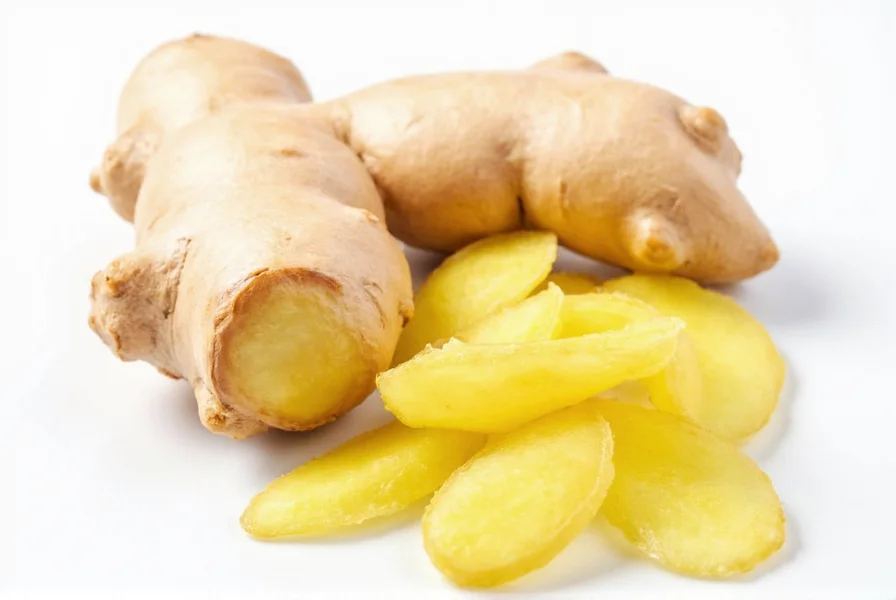Raw ginger has been used for centuries in traditional medicine and culinary practices worldwide. This knotted rhizome packs a powerful punch of bioactive compounds that provide numerous health benefits when consumed properly. Understanding how to incorporate raw ginger into your diet safely can help you maximize its advantages while avoiding potential side effects.
Nutritional Powerhouse: What's in Raw Ginger
Fresh ginger root contains a unique blend of bioactive compounds that contribute to its health properties. The most notable is gingerol, which gives raw ginger its characteristic pungent flavor and provides most of its therapeutic benefits. One tablespoon (about 6 grams) of freshly grated ginger contains:
| Nutrient | Amount per Tbsp (6g) | % Daily Value |
|---|---|---|
| Calories | 5 | 0% |
| Carbohydrates | 1g | 0% |
| Fiber | 0.1g | 1% |
| Vitamin C | 0.3mg | 1% |
| Magnesium | 2mg | 1% |
| Potassium | 29mg | 1% |
While the vitamin and mineral content appears modest, raw ginger's true value lies in its phytochemical composition, particularly gingerols, shogaols, and paradols, which have demonstrated anti-inflammatory and antioxidant properties in numerous scientific studies.

Science-Backed Health Benefits of Consuming Raw Ginger
Research supports several health benefits associated with moderate raw ginger consumption. Unlike cooked or processed ginger, raw ginger preserves higher concentrations of gingerol, the compound responsible for many therapeutic effects.
Digestive Support and Nausea Relief
Raw ginger has been shown to accelerate gastric emptying and reduce nausea. A 2020 meta-analysis published in Nutrients found that ginger supplementation significantly reduced nausea severity in multiple populations. This makes fresh ginger particularly valuable for:
- Morning sickness during pregnancy (consult your doctor first)
- Post-operative nausea
- Chemotherapy-induced nausea
- Motion sickness
Anti-Inflammatory Properties
The gingerol in raw ginger inhibits inflammatory pathways in the body. Research in the Journal of Medicinal Food demonstrated that ginger extract reduced markers of inflammation in participants with osteoarthritis. While raw ginger won't replace medication for chronic conditions, it can serve as a complementary approach to managing inflammation.
Antioxidant Effects
Raw ginger contains potent antioxidants that help combat oxidative stress. These compounds may support overall cellular health and potentially reduce the risk of chronic diseases associated with free radical damage.
Potential Side Effects and Safety Considerations
While raw ginger is safe for most people when consumed in food amounts, understanding potential side effects of eating fresh ginger is crucial for safe consumption.
Common Mild Side Effects
Consuming more than 3-4 grams of raw ginger daily may cause:
- Heartburn or acid reflux
- Mouth or throat irritation
- Diarrhea in sensitive individuals
- Increased bleeding risk (due to mild blood-thinning properties)
Who Should Limit Raw Ginger Consumption
Certain populations should exercise caution with raw ginger side effects:
- Pregnant women: While ginger helps with morning sickness, consult your healthcare provider about appropriate amounts
- People taking blood thinners: Ginger may enhance the effects of medications like warfarin
- Those with gallstones: Ginger may increase bile production
- Individuals with diabetes: Ginger may lower blood sugar levels
How to Safely Incorporate Raw Ginger Into Your Diet
Knowing how much raw ginger can I eat daily helps maximize benefits while minimizing risks. Here are practical recommendations for enjoying raw ginger:
Recommended Daily Amounts
For most healthy adults, these amounts of raw ginger are considered safe:
- General wellness: 1-1.5 grams (about 1/4 to 1/2 teaspoon grated)
- Nausea relief: 1-2 grams (up to 1 teaspoon grated)
- Anti-inflammatory support: 2-3 grams (up to 1.5 teaspoons grated)
Practical Ways to Enjoy Raw Ginger
Try these methods for consuming raw ginger benefits without overwhelming your palate:
- Add freshly grated ginger to smoothies
- Steep thin slices in hot water for ginger tea
- Grate over salads or stir-fries just before serving
- Make ginger shots (1 ounce of freshly juiced ginger mixed with citrus)
- Chew small candied ginger pieces after meals

Raw Ginger vs. Cooked or Processed Forms
Understanding the difference between raw ginger and cooked ginger helps determine when fresh is best:
- Raw ginger: Highest gingerol content, strongest flavor, best for immediate nausea relief
- Cooked ginger: Gingerol converts to zingerone (milder flavor), still beneficial but less potent for nausea
- Dried ginger: Contains shogaols (more stable compounds), convenient but less potent than fresh
For maximum benefits of eating fresh ginger, consume it raw when possible, particularly when seeking digestive support or nausea relief.
When to Consult a Healthcare Professional
While raw ginger is generally safe as part of a balanced diet, consult your healthcare provider if:
- You're taking blood thinners or diabetes medications
- You're pregnant or breastfeeding
- You have a history of gallstones
- You experience persistent heartburn or digestive issues after consumption
Frequently Asked Questions
Is it safe to eat raw ginger every day?
Yes, most adults can safely consume 1-3 grams of raw ginger daily. Long-term daily consumption within these amounts is generally well-tolerated, but some people may experience mild digestive discomfort with regular use. If you notice heartburn or other side effects, reduce your intake.
What happens if I eat too much raw ginger?
Consuming more than 4 grams of raw ginger daily may cause heartburn, mouth irritation, diarrhea, or increased bleeding risk. Very high doses (over 10 grams daily) could potentially interact with medications or cause more serious digestive issues. Stick to recommended amounts of 1-3 grams for daily consumption.
Can raw ginger help with nausea immediately?
Yes, raw ginger can provide relatively quick relief from nausea, often within 30-60 minutes. The gingerol compounds work directly on digestive tract receptors. For best results, consume 1 gram of freshly grated ginger or a ginger shot at the first sign of nausea.
Should I peel ginger before eating it raw?
Peeling is optional but recommended for older ginger with thicker skin. Young ginger has thin skin that's safe to eat. If using organic ginger, thorough washing may eliminate the need for peeling. The highest concentration of beneficial compounds is just beneath the skin, so minimal peeling preserves more nutrients.
How long does raw ginger stay fresh?
Whole raw ginger root stays fresh for 3-4 weeks when stored in the refrigerator in a paper bag or wrapped in paper towel inside a sealed container. Peeled and grated ginger lasts about 1 week in an airtight container. For longer storage, freeze grated ginger in ice cube trays with water for up to 6 months.











 浙公网安备
33010002000092号
浙公网安备
33010002000092号 浙B2-20120091-4
浙B2-20120091-4